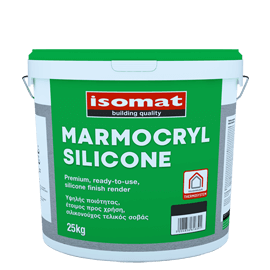MARMOCRYL SILICONE Fine is a pasty, white or colored, silicone-acrylic render consisting of aggregates of special particle size distribution to deliver a smooth decorative finish. It offers the following benefits:
- High elasticity and excellent adhesion to the substrate.
- Total water-repellency according to EN 1062-3.
- Excellent vapor permeability.
- Protection against fungi and algae.
- No need for facade painting.
- Resistance to alkalis, according to DIN 18556.
- Reinforced with polypropylene fibers for effective protection against cracking.
- Simple, faster application.
- Part of ISOMAT THERMOSYSTEM certified external thermal insulation systems.
- Suitability for both indoor and outdoor use.
Certified according to EN 15824:2017. CE marked. MARMOCRYL SILICONE Fine has received an Environmental Product Declaration (EPD) following an assessment of its life-cycle environmental impacts. Registration No: S-P-09188, The International EPD System.
MARMOCRYL SILICONE Fine ise used as a thin-coat render delivering a white or colored, water-repellent smooth finish. Applicable to all building materials including render, concrete, cement boards, gypsum boards, etc. Suitable for interior and exterior wall surfaces. It replaces the final coat in a rendering system. Thanks to its high elasticity and excellent adhesion to the substrate, it is the ideal final coat in external thermal insulation systems.
Substrate preparation
The substrate must be dry and free of dust, oil or grease loose materials, etc. It is then primed with ML-PRIMER. Smooth or non-absorbent surfaces should be primed with PL-BOND. MARMOCRYL SILICONE Fine is applied after the primer has dried.
Application
MARMOCRYL SILICONE Fine should be thoroughly stirred before application with slow circular motions to avoid creating bubbles in the mass of the material. The render is applied by hand, using a smooth, stainless metal trowel, or with a rendering machine. While still fresh (5-20 min after its application), the render is treated (pressed) with a plastic trowel. Working time depends on substrate absorbency and ambient temperature.




